The 13 Best Private Streaming Platforms and Apps in 2025
In 2025, privacy-first video streaming is no longer optional. It is essential for protecting sensitive content and meeting compliance standards. Whether you are hosting a private virtual event, running internal company meetings, or selling exclusive video content, the best private streaming platforms offer the security, flexibility, and branding you need. Modern private live streaming apps provide advanced safeguards such as encrypted live streaming, password-protected video access, DRM, and token-based authentication, ensuring only your intended audience can view your broadcasts.
Today’s secure private streaming platforms and white-label live streaming platforms combine reliability with enterprise video privacy, enabling professional private video streaming experiences on web and mobile while maintaining full control over access, monetization, and distribution. For organizations needing secure OTT video hosting, these solutions also deliver encrypted video delivery and powerful video access control tools to protect high-value content.
In this guide, we explore the best private streaming platforms for 2025, including mobile-friendly apps and enterprise-ready solutions. You will learn how to live stream privately, compare top providers, and discover how to set up a secure private livestream with Dacast for corporate events, training, and OTT distribution. By the end, you will know exactly which private video hosting solution fits your goals, and how to stream a private virtual event securely in 2025.
Table of Contents
- Live Streaming in Today’s Digital Landscape
- What is a Private Livestream?
- How to Stream Privately
- The 13 Best Private Streaming Platforms in 2025
- Best Private Live Streaming Apps for Mobile and Desktop (2025)
- Security Features to Look for in a Private Streaming Platform
- Private Streaming Platforms vs. Free Streaming Sites
- Benefits of Hosting a Private Live Stream
- FAQs
- Conclusion
Live Streaming in Today’s Digital Landscape
Live streaming has become one of the most powerful ways to connect with audiences in real time. Cloudinary research shows that 80% of consumers prefer live video over reading blogs, and 82% choose live streams over static posts. For viewers aged 18–34, more than 60% regularly watch live content, reflecting a shift toward real-time, interactive experiences.
The appeal lies in immediacy and connection. Studies show live streams can hold attention 10–20 times longer than video-on-demand, and Facebook Live videos alone are watched three times longer than pre-recorded clips. This makes private live streaming platforms especially valuable for businesses, educators, and event organizers who want to deliver secure, professional-grade broadcasts.
To expand reach without sacrificing privacy, many use multistreaming—sending a single live feed to multiple destinations such as company websites, video portals, or password-protected channels. This approach allows you to engage diverse audiences while retaining full control through encrypted live streaming platforms and robust video access control tools.
If your goal is to stream securely while protecting intellectual property, corporate data, or event access, the best private streaming platforms in 2025 offer solutions like DRM, token protection, and password-protected video streaming. In the next section, we’ll compare the top private streaming platforms and apps, including how to set up a secure private livestream with Dacast.
What is a Private Livestream?

More is not always the merrier. While sometimes broadcasters stream to reach large audiences, that is not always the case. That’s where private live streams come into play. Sometimes, you want to magnetize viewers from a certain group, area, or industry, not the general masses. Private live streaming offers the perfect solution to secure your stream while engaging a large group of selected audiences.
A private live streaming event is a broadcast meant to be streamed to a select group of people rather than to the public.
There are many events where you may want to limit access and viewership, such as:
- Internal company meetings
- Internal company training
- Private streams to family and friends
- Paid virtual events
There are numerous paid private virtual events you could host, such as:
- Webinars
- Conferences
- Concerts
- Private meet & greets
- Classes
Live streams have many purposes in the world of business video hosting. You could stream webinars, conferences, training sessions, and multiple platforms simultaneously.
Which broadcasts are public and private is to be determined by the broadcaster.
Typically, private video sharing would be intended for internal use. However, you can also use private video sharing for paid public events, where you only want those who paid for access to attend the event.
Public outdoor streaming, for example, would be intended for an audience beyond your company or authorized viewers. There are many use cases for private streams for businesses. Public streaming is when anyone, without any access requirements, can view your live streams.
Some of the most common use cases in 2025 are:
- Virtual shareholder meetings (with voting)
- Medical and telehealth events
- Religious ceremonies with restricted access
- EdTech platforms with class recording access control
- Creator platforms selling gated content
How to Stream Privately
Setting up a private live streaming event is much like setting up any other live-stream. However, you need to take additional measures to ensure that you’re setting up your live event video streaming service correctly for a successful private event streaming experience.
With a private live stream, you need measures that allow you to limit access to your events, such as password protection or domain restrictions.
Let’s run through a quick tutorial on how to stream privately using a private video streaming service.
1. Create a Plan
A successful private stream starts with a clear plan. Define your goals (e.g., internal training, corporate announcements, private events) and identify your target audience—who they are, where they’re located, and how they’ll access the stream. Choose a focused topic that addresses their needs, and prepare a loose outline to keep the session structured.
If you have a team, assign roles such as presenter, moderator, and tech support. Decide early whether you’ll monetize the stream, and ensure your setup meets privacy and delivery needs.
See how Dacast can help you set up a secure private livestream.
2. Choose a Private Streaming Platform
Select a professional private video streaming solution that matches your goals. Look for features such as:
- Password-protected video streaming
- DRM and AES encryption for content security
- HTML5 white-label video player for branding
- Global CDN for reliable delivery
- Video and player APIs for customization
- 24/7 support
Pro Tip: Use Dacast’s Expo 2.0 gallery to create a private video portal that feels like a curated Netflix-style library.
3. Configure Your Streaming Setup
Once you’ve chosen a platform, connect your camera, microphone, and encoder (e.g., OBS Studio, vMix). Ensure your hardware and software are compatible with the platform’s requirements. Configure your encoder for optimal bitrate, resolution, and streaming protocol (e.g., RTMP).
If you’re using Dacast, our Streaming Setup guide and OBS tutorial walk you through configuration from start to finish.
4. Promote Your Event
Even private streams need promotion. Whether it’s through internal channels or a targeted marketing campaign. Collect RSVPs so you can share login credentials with verified attendees. Consider:
- Sending calendar invites
- Creating teaser clips
- Running a countdown page
- Sharing reminders via email or chat
Adapt your promotion strategy to match the privacy level of your event.
5. Confirm Your Privacy Settings
Enable platform security controls before going live:
- Password protection
- AES encryption
- Domain and geographic restrictions
- HTTPS delivery
- Token-based authentication
These tools ensure your event remains a secure live video streaming experience for invited viewers only.
6. Protect Against Video Piracy
Prevent unauthorized sharing by enabling DRM, watermarking your videos, and restricting player embedding to approved domains. This is especially important for paid or sensitive content, such as corporate meetings or proprietary training.
For details, see our guide on encrypted video delivery platforms.
7. Start Streaming
Run a test broadcast to check audio, video, and connectivity before going live. Assign someone to monitor the stream in real time to quickly address any issues for viewers.
8. Consider Repurposing Your Private Live Stream
After your event, maximize ROI by repurposing the recording:
- Publish as on-demand content for internal or paid access
- Create highlight reels for marketing
- Extract audio for podcasts
- Share behind-the-scenes moments on internal channels
Dacast makes it easy to store and manage your recordings through its secure OTT video hosting tools.
Now that you know how to host private live streaming and what security features you’re looking for, you’re likely left wondering which private streaming service is best. That’s why we’ve reviewed the top secure private streaming platformson the market. These services are long-standing, robust competitors offering various compelling features.
As you know, however, different users have different needs. By taking a closer look at the features and costs of solutions, you can make an informed decision about the right video platform.
We’ve evaluated many private live streaming options and narrowed it down to the top 10 private streaming platforms for broadcasting private and virtual events in 2025. Here they are.
The 13 Best Private Streaming Platforms in 2025
Now that you know how to host private live streaming and what security features you’re looking for, you’re likely left wondering which private streaming service is best. That’s why we’ve reviewed the top secure private streaming platforms on the market. These services are long-standing, robust competitors offering various compelling features.
As you know, however, different users have different needs. By taking a closer look at the features and costs of live-streaming solutions, you can make an informed decision about the right video platform.
We’ve evaluated many private live streaming options and narrowed it down to the top 10 private streaming platforms for broadcasting private and virtual events in 2025. Here they are.
1. Dacast

Dacast is one of the leading online video platforms with a full-featured, self-service solution for live streaming and private video hosting.
Dacast’s acquisition of Vzaar, a video hosting, and distribution platform, has made our platform even more powerful and useful to broadcasters.
When it comes to security and privacy controls, Dacast gets an A+. This streaming platform makes broadcasting private live streams a breeze.
Basic Functionality
Dacast is known for its easy-to-use platform and custom white-label streaming solution. Brand new broadcasters can create a live channel, stream in minutes, and maintain 100% content ownership.
The platform was designed for professional broadcasters with security in mind and featured a robust video solution that meets their business requirements. Dacast offers many advanced features for private live streams, including top-notch AES encryption, a video paywall for monetization, password protection, referrer restriction, and an analytics dashboard to track user events.
Key Features
Dacast offers high-end features with competitive pricing plans. These include ad-free broadcasting, white-label service, and secure CDN video delivery.
It is also one of the few streaming solutions of its caliber that offer video delivery to China.
Detailed Features
- Multi-CDN streaming
- WebRTC browser streaming
- DRM with AES-256 encryption for VOD and live content
- JSON-LD video SEO for discoverable yet protected streams
- Secure, global content delivery, including industry-best video hosting
- 24/7 tech support with all plans, including email and live chat
- Secure video upload features, including content management, library migration, and video replacement
- RTMP Encoder for ingesting HLS
- Player API access for 3rd party player integration
- Video API access on premium plans (scale and event)
- Best-in-class private RTMP server
- Adaptive multi-bitrate streaming
- Cloud-based video transcoding
- Real-time video analytics
- Ad-free streaming
- Multi-user access on Scale and Custom plans
- Zoom live streaming integration for meetings and live events in real-time
- Expo 2.0 galleries video portal for immersive video experiences
- AES video encryption for advanced streaming security
New!
- M3U8 file creation capability to enable adaptive streaming delivery of OTT video content across various devices
- Fully integrated RTMP streaming platform features
- Advanced API to build your own video CMS
- AES video encryption for advanced streaming security
- Multi-user access (MUA) on Scale and Custom plans
- Zoom live streaming integration for meetings and live events in real-time
- Expo 2.0 galleries video portal for immersive video experiences
- Authenticate-only paywall for no payment content gating
- Plays by Location geographical insight
- Chinese streaming platform support
- Digital Rights Management (DRM) for VOD
- Multi-CDN streaming for high-quality broadcasts
- Browser-based live streaming with WebRTC
Pros
- Live streaming and VOD packages on all pricing plans
- Unlimited viewers and live channels
- White label and branding control
- Embeddable HTML5 video player
- SVOD, AVOD, and TVOD monetization options
- An integrated video paywall
- Mobile device support
- Live stream recording
- China Video Hosting
- Plans for every budget
Cons
- Requires a bit of a learning curve
Upload Guidelines and Specs:
- Minimum dimension: none (but 240p is the recommended minimum)
- Maximum dimension: 1080p or 4K (depends on the user’s hardware and internet)
- Video aspect ratio: no restrictions (but 16:9 is the default)
- Max file size: none
- Max video length: none
- Total file storage: 10-1000GB (depends on plan)
- Compatible video formats: MP4 (preferred), MOV, M4V, M2V, AVI, MPG, FLV, WMV, MKV, WEBM, OGV, MXF, ASF, VOB, MTS
Pricing
Dacast includes four packages in their streaming pricing plans:
- Starter plan: $39/month (billed annually); ideal for newcomers with 2.4 TB of bandwidth and 500 GB of storage per year
- Event plan: $63/month (billed annually); for organizations that would rather not sign a contract, and want to purchase bandwidth separately to offer 6 TB of bandwidth upfront, 250 GB of storage; additional data and storage can be added as needed
- Scale plan: $165/month (billed annually); includes 24 TB of bandwidth per year, with 2 TB of storage; add phone support, monetization paywall, an for live channels, ad insertion, white-label video player, and; additional bandwidth is available upon request for monthly plans
- Custom plan: if your enterprise business has high-volume streaming needs, you can for a custom plan tailored to your needs.
Dacast has all the tools you need to securely host private live streaming, making it one of the best platforms you can work with.
Best for: Secure corporate events and enterprise-grade private video hosting with DRM, token protection, and password-protected streaming.
2. Vimeo
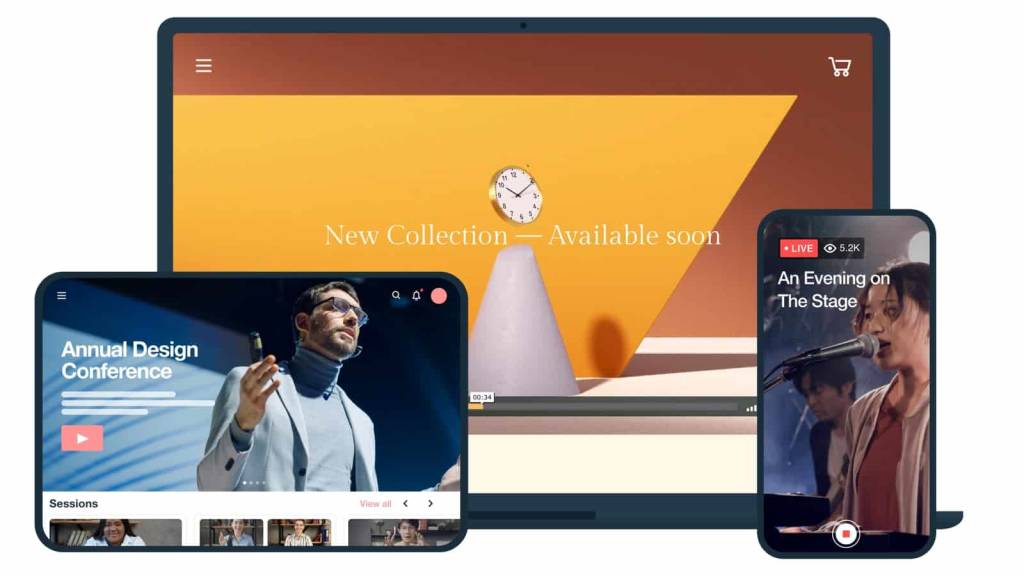
Since its founding in 2004, Vimeo has grown to be one of the most well-known video platforms on the internet.
Originally, Vimeo made its mark by offering an ad-free experience for video sharing, which made it an instant hit with creators and audiences. Now, it offers live streaming and enterprise video hosting space, with a range of services targeting businesses of all sizes.
The platform emphasizes quality over quantity, which is appealing to many professional creators and businesses. Vimeo offers a cleaner user experience and a vast array of customization options.
Basic Functionality
Vimeo is a AI-powered cloud-based video streaming platform with comprehensive video hosting and live streaming functionality. Vimeo has a simplified live streaming interface with features like text and graphic overlays and social share options. It also has plenty of tools that help with greater audience interaction. Live support comes with Premium and Vimeo OTT custom plans.
Key Features
- Cloud-based video hosting
- Small-scale streaming solution
- Text and graphic overlay
- Collaboration and interaction tools
- Social share options
- Flexible storage options
Detailed Features
- Video management platform
- Insightful analytics
- High-quality streaming capabilities
- Great storage capacity
- Privacy and security controls
Pros
- User-friendly interface with simple navigation
- Great in-class security and privacy settings
- Good video playback quality
- No limitations on the number of events and viewers
- No advertisements
- Visually appealing portal
- Powerful analytics
- Pay-per-view option
Cons
- Some issues with connection to an internal server
- No China video delivery
- Limited live streaming and video hosting capabilities
- Requires you to be tech-savvy to take full advantage of its features and have everything running smoothly
- The live event management system is pricier than other services and lacks robust features you’ll find on other platforms
- Buffering times are longer than other cloud video services
- You can’t convert the text in English to other languages.
Upload Guidelines and Specs
- Recommended dimension: 720p (1280 x 720)
- Aspect ratio: 16:9, 4:3
- Max file size: 3GB
- Max video length: Information not available
- Total file storage: Information not available
- Compatible video formats: MP4 (recommended)
Pricing
Vimeo offers basic video hosting plans that are suitable for content creators and startups.
Pricing if billed monthly, is as follows:
- Free: $0/month; 1 GB storage, creation and editing, screen recording
- Starter: $20/month; 100 GB storage, auto closed captioning, custom URLs and video player, privacy tools
- Standard: $41/month; 1 TB storage, engagement and social analytics, AI script generator, teleprompter, brand kit
- Advanced: $108/month; 5 TB storage, stream to multiple destinations, host live broadcasts and webinars, AI-generated chapters and text summaries
- Enterprise: Custom pricing; more storage and bandwidth, advanced AI capabilities, quality events, dedicated support
Vimeo is great if you want to maximize the usage of your content by turning your live streams into VOD content.
Best for: Creative professionals and brands needing high-quality private video hosting with strong access control tools.
3. JW Player

JW Player is a private video streaming service that originated in 2005. The technology used in this platform’s video player was originally a part of the open-source code that eventually contributed to the original YouTube video player.
JW Player was originally known for its HTML5 video player for VOD platforms. In recent years, JW expanded its platform to include live-streaming capabilities.
Basic Functionality
One of the most valuable aspects of JW Player is that it supports MPEG-DASH playback, CSS skinning, DRM, and other advanced features that other OVPs do not have.
Key Features
- Live streaming and video-on-demand (VOD) hosting
- Cloud-based content management platform
- Custom video galleries
- Up to 1080p HD streaming
- Support for monetization via advertising
- Multi-bitrate and adaptive streaming
- Email support through the $100/month plan level
- Video API access on all plans
- Only custom-priced Enterprise plans offer DRM
- Monetization via advertising
Detailed Features
- Multi-bitrate and adaptive streaming features
- Global content delivery
- Tech support with the most inclusive plans
- Video API access
- DRM with Enterprise Plans
- Monetization
Pros:
- HD streaming
- Video recommendations engine to generate custom “watch next” recommendations for increased viewership
- Global content delivery
Cons:
- No China video delivery
- Only basic security features
- Only ad-based monetization
Upload Guidelines and Specs
- Minimum dimension: 360p (640 x 360)
- Maximum dimension: 1080p (1920 x 1080)
- Aspect ratio: 16:9, 4:3, 2.39:1
- Max file size: 25GB
- Max video length: Not available
- Total file storage: 25GB to 500GB (depending on the plan)
- Compatible video formats: MP4, WMV, AVI, MOV, 3GP, FLV
Pricing
The JW Player pricing structure is based on custom needs. Contact their sales team to discuss your requirements and get a bespoke price.
You can choose between the following plans:
- Stream: This plan offers video delivery, asset management, instant and broadcast live
- Play: This plan offers cloud hosting, HTML5 Player, OTT apps, and mobile SDKs
- Engage: Take advantage of real-time analytics, recommendations, article matching, and custom reports
- Monetize: Use tools like ad insertion, player bidding, outstream ads, and studio DRM
Publishers and broadcasters should contact JW Player directly for pricing and features.
Best for: publishers and media companies that need fast, encrypted video delivery and robust monetization options.
4. Wowza
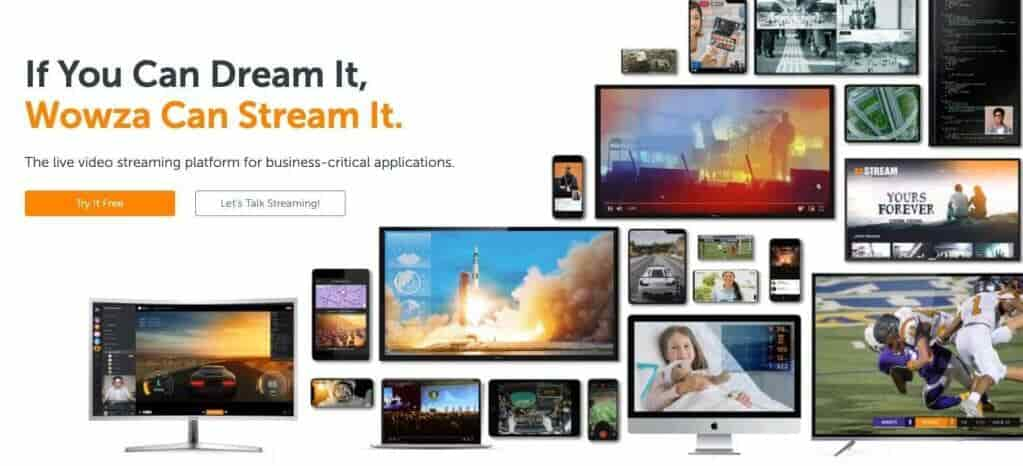
Wowza is a private video streaming service founded in 2005 as a bootstrap start-up. It offers private live streaming and on-demand video hosting. Wowza is also known for its top-notch security features.
Wowza offers two main products. The first is the Wowza Streaming Engine. This product is widely used in the industry for self-hosted streaming. The second is the Wowza Streaming Cloud offering.
Basic Functionality
This functionality includes various features aimed at providing low-latency content access to global audiences.
Key Features:
- Video content management
- Supports high-definition streaming
- Robust security features
- Video API
- Simulcasting capabilities
Detailed Features
- Cloud management services
- High-def streaming (up to 4K)
- Powerful security and privacy features
- Access to APIs
Pros:
- Powerful security
- Supports streaming on most devices
- Live streaming and video-on-demand
- Connects with Google Analytics
- China video delivery
Cons:
- Monetization through integrations only
Upload Guidelines and Specs
- Minimum dimension: 240p (320 x 240)
- Maximum dimension: 4K (3840 x 2160)
- Aspect ratio: 16:9, 4:3
- Max file size: Not available
- Max video length: Not available
- Total file storage: 250 GB (depends on the plan)
- Compatible video formats: MP4, FLV, MP3, SMIL, AMLST, ID3, NGRP
Pricing
Wowza recently overhauled its pricing plans and added several options. These are split into 2 main tiers: Streaming Video Cloud Streaming and Streaming Engine.
The Wowza Video Streaming Cloud offers distinct pricing plans and services. Live Event Pricing, monthly plans include:
- One Month Event: $149 one-time purchase; includes 15 hours of live streaming and 500 viewing hours
- Pay as you go: $0/month; $2.50/hour of streaming, all usage billed separately
- Enterprise: Plans built for your needs; contact sales for custom pricing
The Wowza Streaming Engine has its own pricing plan packages. These professional-grade streaming plans are billed annually and include:
- Basic: $175/month + $195/month for each additional instance and $125/month for each additional prepaid instance
- One Month Event: $295/month + $295month for each additional instance
- Enterprise: Please contact Wowza directly for access to their custom-tailored high-volume enterprise solutions
If you need a budget-friendly video hosting platform with streaming security, try Wowza.
Best for: Developers and IT teams building custom encrypted live streaming platforms with API flexibility.
5. IBM Video Streaming

IBM Video Streaming, previously IBM Cloud Video, was founded over a decade ago to connect military personnel overseas with loved ones back home. The private video streaming service was formerly UStream, but IBM acquired it in 2016.
Basic Functionality
IBM Video Streaming is primarily a live-streaming company but also has VOD capabilities. This OVP offers two main packages: free, paid, and enterprise. Most features are available with paid packages, but the enterprise packages are all-inclusive.
Key Features:
- Live and on-demand video streaming
- Secure sharing of online content
- Enterprise content delivery network
- Video distribution and workflow
- OTT video management
- Video monetization
Detailed Features
- Video Marketing
- Live streaming and live event coverage
- Enterprise video streaming
- Video distribution and workflow
- OTT video management
- Monetization capabilities
Pros:
- One of the best-streaming cloud storage set-ups, with reliable cloud streaming.
- Responsive customer support, helping you if you ever run into issues.
- Enterprise-grade video capabilities for large organizations, r
- Hong Kong (China) video hosting.
- Impressive analytics feature where you can monitor various KPIs of live streaming.
- You can easily upload video files and media for your audience during the live broadcast.
Cons:
- Uses an internal content delivery system
- General plans don’t offer APIs
- The chat feature isn’t the best given that this supports a large audience
- Users report issues with data synchronization and upload when there’s heavy traffic on the platform.
- The file management system isn’t good if you have many files because it gets challenging to find what you’re looking for.
- Although it allows non-hosts to interact with the broadcast and share files, the permission-granting process is tricky and requires a learning curve.
Upload Guidelines and Specs
- Minimum dimension: 480p (480 x 270)
- Maximum dimension: 4K (3840 x 2160)
- Aspect ratio: No published aspect ratio
- Max file size: 4 GB
- Max video length: No published limits
- Total file storage: 1TB – 5TB (depends on plan)
- Compatible video formats: MKV, MP4, MOV, FLV, AVI, WMV, MPEG2, H264, H263, MPEG4, VP6, VP8, THEORA, WMV, MP3, AAC-LC, NELLYMOSER, PCM, SPEEX, VORBIS, WMA
Pricing
The pricing plans for the IBM Cloud Video include:
- Start Trial – Video Streaming: Give it a free test drive for 30 days
- Silver: Affordable Essentials, 100 viewer hours, 5 channels, 1 TB video storage, starting at $145/month
- Gold: Standard business features, 2,000 viewer hours, 10 channels, 2 TB video storage, starting at $729/month
- Platinum: Premium Volume scale, 5,000 viewer hours, 20 channels, 5 TB video storage, starting at $1,460/month
- Custom: Please contact IBM Cloud video for custom plan pricing as well as payment plans
Best for: Large enterprises requiring confidential live video solutions with advanced compliance features.
6. Brightcove
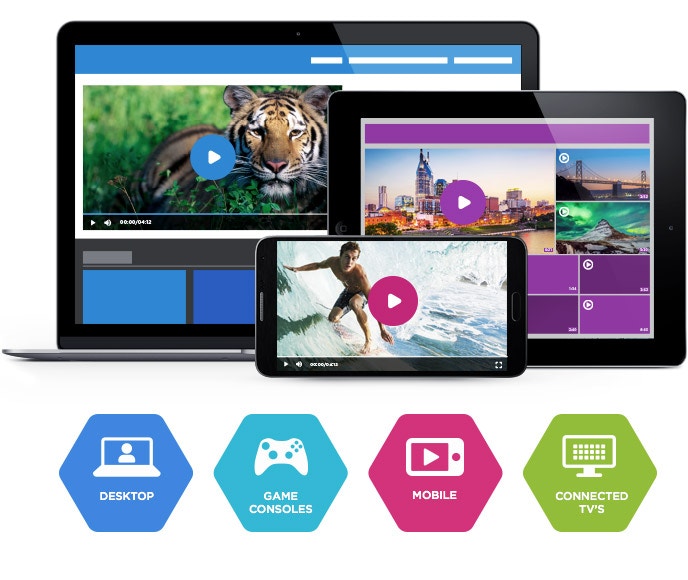
Founded way back in 2004, Brightcove is among the market’s oldest private live-streaming platforms. Brightcove supports both live streaming and VOD hosting.
Brightcove’s custom plans have outstanding security features, but its more basic plans do not.
Basic Functionality
Brightcove provides a few different services. These include Video Cloud hosting, a video player, server-side ad insertion, video streaming capabilities, OTT streaming tools, cloud transcoding, and tools for monetization.
Key Features:
- Live streaming through Video Cloud
- Over-the-top (OTT) streaming
- Advertising and monetization
- Numerous cloud app integrations
- Offers customizable branding features
- On top of the video analytics and reporting feature, it has the option to track your ROI.
Detailed Features
- Global content delivery
- Multi-bitrate and adaptive streaming
- Basic tech support
- Limited API access
- Limited security features
- Limited monetization options
- Best for clients with large budgets
Pros:
- A straightforward cloud interface that’s easy for people to use.
- Offers built-in integrations for other cloud apps, allowing you to integrate your video content with other business tools easily.
- High-quality privacy and security.
- Share your live streams in private groups and with the public through your social media channels.
- One of the best cloud storage for video production, so you can neatly categorize your videos and save them in various playlists.
- All the essential editing tools you need to make small changes to your videos, which is especially beneficial if you often repurpose your live streams.
Cons:
- Lack of fine-grain analytics or reporting
- No China video delivery
- 24/7 support isn’t free
- Although the analytics feature is present, you have to go through some manual workarounds to compare the reports of different videos.
- You can’t find data on the number of unique viewers on your videos or track the number of users at specific time markers.
Upload Guidelines and Specs
- Minimum dimension: Determined by the user
- Maximum dimension: Determined by the user
- Aspect ratio: No restrictions (since Brightcove uses a responsive player)
- Max file size: No limits on file size
- Max video length: No published limits
- Total file storage: Varies by plan
- Compatible video formats: MP4, MOV, FLV, AVI, WMV, MKV, 3GPP
Pricing:
Brightcove builds custom pricing plans to suit enterprise streaming needs. Here is what we currently know about their pricing structure:
- Basic Plan: Starts at $99 per user per month, which includes core video hosting and management functionalities. This plan is well-suited for businesses with basic video needs, such as small content libraries or internal communications.
- Enterprise-Level Plans: These plans are highly customizable and include advanced features such as live streaming, in-depth analytics, security options, and robust integrations. Pricing is tailored depending on the specific needs of the business, including audience size, storage requirements, and additional services like video monetization and support.
- Customization Costs: Enterprises may face additional expenses for features like platform customization, data migration, employee training, and ongoing maintenance. These costs can range from a few thousand dollars to significantly more, depending on the complexity of the requirements.
- Free Trial: Brightcove offers a free trial for prospective users to test its features before committing to a subscription, which is a helpful option for evaluating its capabilities in real-world scenarios.
Interested broadcasters can contact their sales department to receive a quote or sign up for a 30-day free trial. When you need something simple with complex tools, Brightcove is a good choice.
Best for: Global brands seeking an enterprise video platform with DRM and secure OTT video hosting.
7. Kaltura
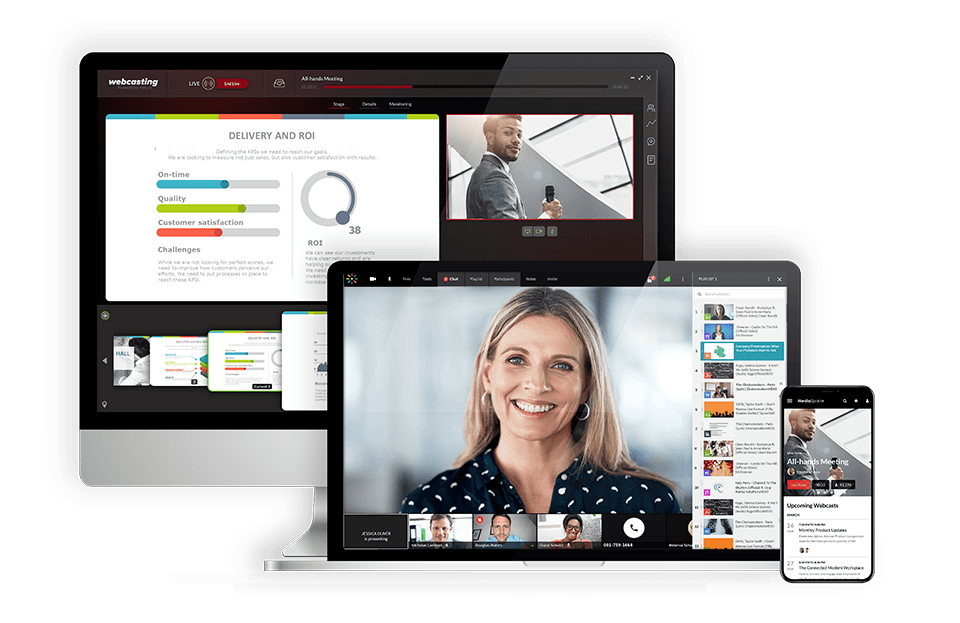
Kaltura is one of the leaders in the private live-streaming space. This platform was initially geared toward meeting the needs of educational institutions, but now it serves organizations in several realms.
Kaltura has a broad range of security features that make it great for private live streaming.
Basic Functionality
Kaltura is a cloud-based video hosting and distribution service. It has both VOD hosting and private live-streaming capabilities.
Kaltura is considered an “open-source” platform instead of a traditional self-hosting platform.
Key Features:
- Cloud video hosting and streaming
- Cloud TV service
- Advanced Security in the Cloud
- Highly customizable
- Integrations for any feature imaginable
Detailed Features
- Multi-bitrate and adaptive streaming options
- Bring your own CDN capabilities
- Top-notch security
- Ticket-based tech support
- API access
- Monetization capabilities
Pros:
It is designed specifically for education and large enterprise uses. They offer various monetization options, making it a great choice if you want to earn money through your content.
Cons:
- Many options for customization may get complex for beginners
- Slow uploads to the cloud
- No China video delivery
- Users complain about the lack of sufficient customer support
Upload Guidelines and Specs:
- Minimum dimension: 180p (320 x 180)
- Maximum dimension: 1080p (1920x 1080)
- Aspect ratio: 16:9, 4:3
- Max file size: 2GB
- Max video length: Not available
- Total file storage: 10GB to Unlimited (depends on the plan)
- Compatible video formats: MOV, MP4
Pricing
Prices are based on the solutions you’re looking for. These include but are not limited to:
- Limited Trial: $1 for two webinars
- Business: $199/month (or $150/month when billed annually)
- Enterprise: Custom pricing
- Free trial: 14 days; up to 25 participants per session
- Basic: $19/month (or $17/month when billed annually); up to 8 participants per session and 8 hrs of cloud recording
- Pro: $55/month (or $50/month when billed annually); up to 25 participants per session and 15 hrs of cloud recording
- Business: $125/month (or $115/month when billed annually); up to 100 participants per session and up to 25 hrs of cloud recording
- Business Plus: Custom pricing for up to 300 participants per session, unlimited sessions and custom storage needs
- Annual discounts: Discounted pricing packages available for any scale and use-case, enterprise SLA, and developer support
- Limited trial account: $1 for $100 worth of credits for 30 days for testing and experimentation, with no commitments
- Pay as you go – You pay only for what you use at these credit levels:
- Base plan: $20 one-time annual fee + monthly usage fees
Other services include virtual events, video portal town halls, video messaging, meetings and more.
Best for: Universities and training providers offering professional private video streaming for education and internal events.
8. Muvi
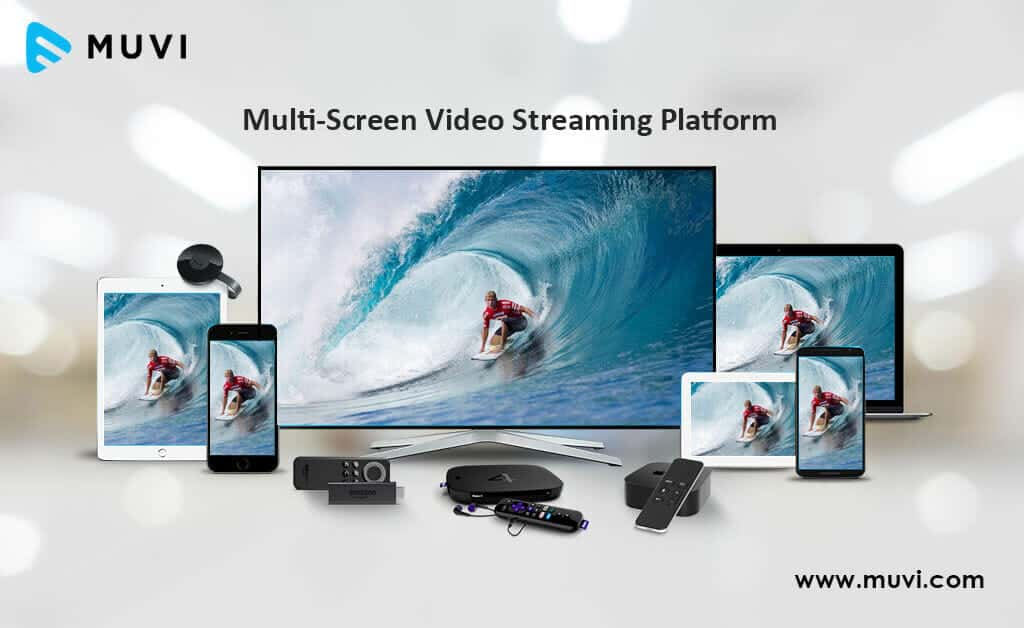
Muvi is a private on-demand video hosting platform that offers specialized support for OTT media businesses. Regarding OTT media distribution, privacy and security are a must for limiting access to paying customers only and avoiding piracy.
Overall, Muvi aims to provide a “turnkey” service to broadcasters. In short, Muvi focuses on OTT services that quickly get up and running. They say their model empowers users to launch their video or audio strategy quickly and easily.
Basic Functionality
Muvi’s OTT multi-screen video streaming solution helps businesses launch white-label multi-device streams. They also provide VOD and audio streaming. It’s fully managed and all controlled from a single CMS.
Key Features
- White-label platform: Customizable branding for a unique user experience.
- Multi-device support: Accessible on web, mobile, smart TVs, and gaming consoles.
- Monetization options: Subscriptions, pay-per-view, and ad-based models.
- Advanced security: DRM, encryption, and secure video player for content protection.
- Analytics: Detailed insights into viewer behavior and performance metrics.
- Content management: Easy upload, organization, and distribution of media.
Detailed Features
- Custom branding
- HTML5 video player
- Analytics
- Monetization options
- DRM and security features
Pros
- User-friendly interface
- Robust security features
- Comprehensive monetization options
- High scalability and reliability
- 24/7 customer support
Cons
- Higher pricing for advanced features
- Steeper learning curve for beginners
- Limited third-party integrations
Upload Guidelines and Specs
- Minimum dimension: 144p (256 x 144)
- Maximum dimension: 4K (3840 x2160)
- Aspect ratio: 16:9, 4:3
- Max file size: not available
- Max video length: not available
- Total file storage: 1TB, 2TB, 5TB (depending on the plan)
- Compatible video formats: MP4, MOV, MKV, FLV, VOB, M4V, AVI, 3GP, MPG
Pricing
Muvi has 7 pricing plan categories, namely One, Live, Flex, Player SDK, Playout, TV and Alie.
1. The pricing for Muvi One includes the following plans:
- Standard: $399/month
- Professional: $1,499/month
- Enterprise: $3,900/month
- Ultimate: ask sales for price
Each plan has different features, such as the number of concurrent users, hosting options, and add-ons like the Alie recommendation engine. You can visit Muvi One Pricing for more details.
2. The pricing breakdown for the Muvi Live plans is as followed:
- Standard: $99/month
- Professional: $299/month
- Enterprise: $799/month
Each plan includes unlimited events and meetings, mobile live streaming, Ad-free high quality Streaming and custom branding and more. You can visit Muvi Live Pricing for more details.
3. Muvi Flex includes the following plans :
- Standard: $199/month
- Professional: $899/month
- Enterprise: $2,899/month
Each plan includes unlimited content and views, with varying features like the number of concurrent users, hosting options, and customization availability. Visit Muvi Flex Pricing for full details.
4. Here is the summary for the Muvi Player SDK pricing:
- Pay as You Go: $0/month + $0.001 per view (first 100 views are free)
- Enterprise: $499/month + $0.001 per view (first 100,000 views are free each month)
Visit the Muvi Player Pricing page for more detailed information.
5. Muvi Playout includes the following plans:
- Standard: $199/month
- Professional: $499/month
- Enterprise: $1,999/month
These plans differ in features such as the number of concurrent viewers, channels, and customization options. The Enterprise plan also offers dedicated servers. For more detailed features, visit the Muvi Playout Pricing page.
6. The pricing breakdown for Muvi TV is:
- Standard: $9/month + 9% commission on content sales.
This plan supports global distribution, and features include unlimited content, views, and the ability to publish and monetize quickly. For more details, visit the Muvi TV Pricing page.t
7. The pricing details for Muvi Alie is:
- Standard: $199/month
- Professional: $899/month
- Enterprise: $1,499/month
These plans differ in features such as ingestion features, training and recommendation requests. Visit the Muvi Alie Pricing page for more details.
Best for: OTT businesses needing a white-label live streaming platform with secure subscription and pay-per-view models.
9. StreamShark
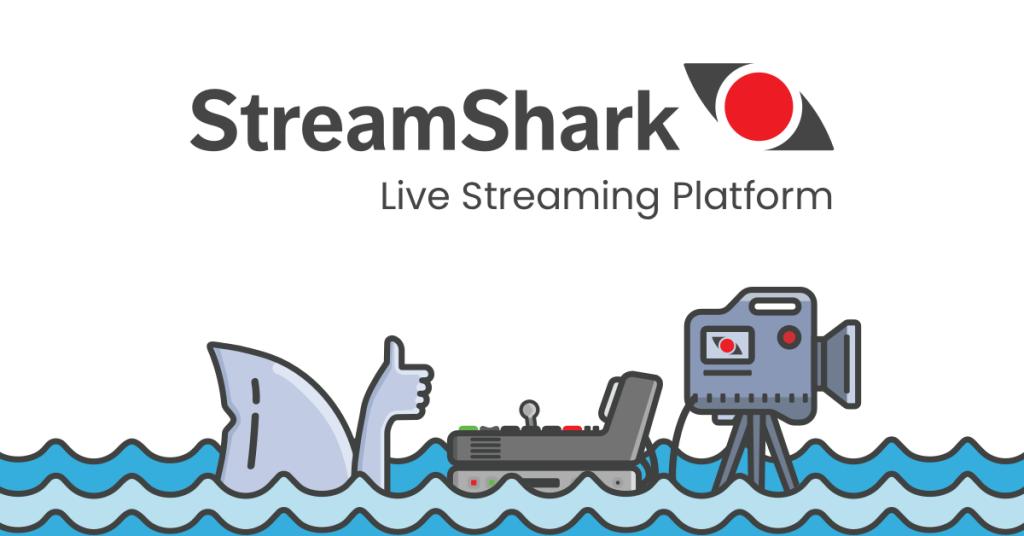
StreamShark is another great private live-streaming platform. It was founded in 2011 and provided multi-faceted online video functionality.
This platform is a product of MetaCDN, an Australian content delivery company. In addition to powerful content delivery, StreamShark is known for its innovative features in the live streaming space. The most notable features are 360 live streaming, peer-to-peer streaming, and enhanced streaming security.
Basic Functionality
StreamShark is an online video platform specializing in secure live streaming.
Key Features
- Manage different phases of an event’s stream
- Multi-vendor approach
- HLS ingests
- Provides global video CDN services
- Innovative live streaming tools
- Enhanced security for private streaming
Detailed Features
- Mobile compatibility
- Peer-to-peer streaming
- 360 live streaming
- Detailed viewer reports
- Customizable live-streaming video player
- Global coverage via a multi-CDN network
- Privacy controls
- Advertising and customer support
Pros
- Localized media ingestion
- monetization options
- Video Encoding
- Redistribution
- Increased storage space
Cons
- No live tech support
- No embeddable playlists
- Fair to no video analytics
- No China video delivery
Upload Guidelines and Specs
- Minimum dimension: 240p (426 x 240)
- Maximum dimension: 1080p (1920 x 1080)
- Aspect ratio: 16:9, 4:3
- Max file size: not available
- Max video length: not available
- Total file storage: 500GB, 1TB, 3TB
- Compatible video formats: HLS, WebM VP9, WebM VP8, WebM VP9 DASH, MP4
Pricing:
Monthly live streaming plans with StreamShark begin at $199 per month and include the following:
- Standard: $199/month; includes 1,000 GB of bandwidth; 500 GB of VOD storage an additional overage of $0.10 per GB
- Team: $499/month; includes 4,000 GB of bandwidth; 2,000 GB of storage, and lowers per GB overage prices to $0.09 per GB
- Business: $999/month; includes 9,000 GB of bandwidth; 5,000 GB of storage, and reduces the overage to $0.08 per GB
- Enterprise: Please contact StreamShark for their custom enterprise solutions and plans
Best for: Hybrid event organizers that require encrypted live streaming and audience access control tools.
10. Panopto
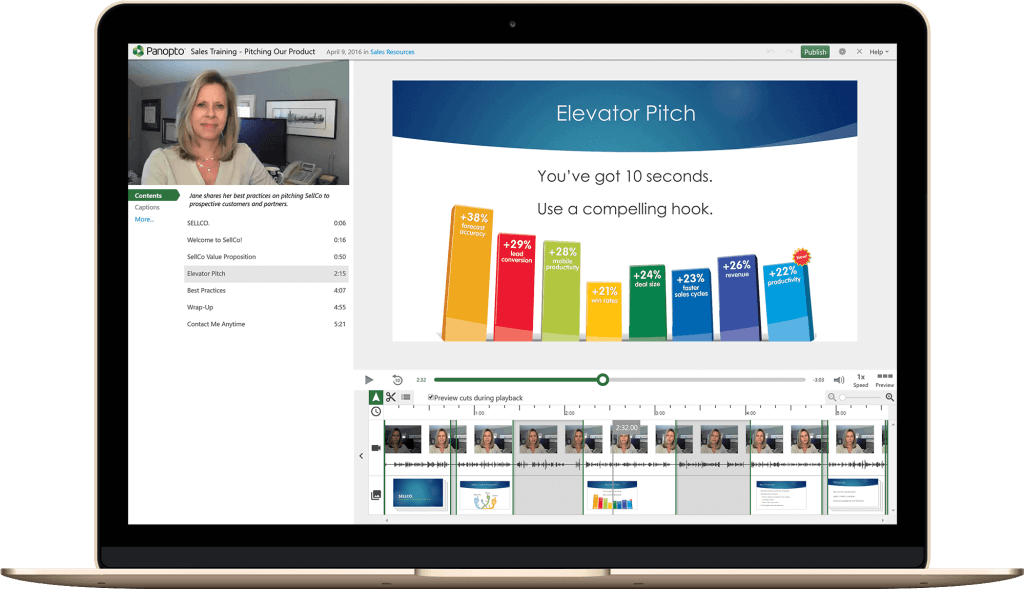
Panopto is a private live-streaming platform that is geared toward educational and institutional users. This platform aims to deliver an “internal YouTube” experience for training and more.
It was founded in 2007 in Pittsburgh at Carnegie Mellon University as a tech project. This online video streaming solution enables streaming, sharing, recording, and managing of video content.
Panopto has more than 100 employees in 6 offices around the world. The streaming solution serves an audience of over 5 million end-users in e-learning.
Basic Functionality
With a focus on online education, it provides tools similar to YouTube and integrates with Learning Management Systems. Panopto is a more focused online video organization than the other private live streaming platforms we’ve considered.
Key Features
- Secure portal for management
- Includes software for live streaming and auto-archiving using webcams
- Keyword search inside videos
- Tools for API access and LMS/CMS integration
Detailed Features
- Lecture-capture and video-search software
- Access control & security features
- White-label streaming
- Integration with LMS systems
- API for further integrations.
Pros
- Audio Content
- Analytics
- Document Indexing
- Customizable Branding
- Full-Text Search
- Video Content
- Asset Categorization
- China video delivery
Cons
- No customizable templates
- No image editor
- No SEO management
- No version control
Upload Guidelines and Specs
- Compatible video formats: AVI, MP4, MPG, WMV, MOV, QT, ASF, 3GP, WMA, MP3, M4V
All other upload guidelines and specs are only available to paying customers.
Pricing
Panopto no longer offers pricing information on its website, so you have to get in touch with their team to find out custom pricing for your requirements. For specific plans and pricing, contact sales.
After establishing a contract, you have access to unlimited streaming and storage. However, this aspect may represent a potential downside for some streamers as Panopto does not handle any external-facing video content.
Panopto understands the needs of educational institutions, making it a great platform for educational institutions.
Best for: EdTech and corporate training teams delivering password-protected video streaming and secure content archives.
11. Uscreen

Uscreen is one of the most popular private video hosting solutions for creators, coaches, and educators who want to offer on-demand courses or subscription-based streaming.
This white-label live streaming platform allows users to launch branded OTT apps for web, mobile, and TV, making it ideal for professional private video streaming in 2025. Uscreen combines easy-to-use tools with enterprise-level security, ensuring content is accessible only to authorized viewers through password protected video streaming and DRM support.
Basic Functionality
Uscreen’s core focus is helping businesses and creators monetize video content securely. You can create a private live stream, sell subscriptions, or set up pay-per-view events. The platform supports both live and on-demand video, with flexible OTT app deployment across iOS, Android, Roku, and more.
Key Features
- White-label OTT apps for multiple platforms
- Secure OTT video hosting with DRM
- Integrated subscription billing and pay-per-view
- Encrypted live streaming platforms for premium events
- Video access control tools including geo-blocking and password protection
- Analytics dashboard for viewer insights
Pros
- Excellent for e-learning and membership-based streaming
- Mobile-friendly private streaming apps
- Flexible monetization options
- Strong branding customization
Cons
- Pricing is higher than some competitors for small creators
Pricing
Uscreen pricing starts at $149/month plus a per-subscriber fee, with higher tiers for advanced app development and API integrations.
Best for: Creators and educators selling private courses through a secure OTT video hosting platform.
12. Zype

Zype is a secure OTT video hosting platform built for developers, media companies, and enterprises that need advanced control over their streaming workflows.
It stands out among the best private streaming platforms 2025 for its developer-friendly API, token-based authentication, and encrypted video delivery platforms. Zype is ideal for organizations that want to integrate secure private streaming into existing apps or websites.
Basic Functionality
Zype offers a cloud-based video CMS, automated transcoding, and flexible content distribution. It’s a powerful choice for professional private video streaming with custom integrations.
Key Features
- API-first design for custom video apps
- Secure live video streaming with DRM
- Advanced analytics and audience segmentation
- Multiple monetization models (AVOD, SVOD, TVOD)
- Encrypted live streaming and OTT app publishing
- White-label live streaming platform branding
Pros
- Highly customizable for developers
- Enterprise-grade security
- Flexible monetization options
Cons
- Requires technical expertise for setup
Pricing
Zype pricing is quote-based depending on bandwidth, storage, and API usage.
Best for: Developers building custom OTT apps with enterprise-level encrypted video delivery.
13. Restream Business
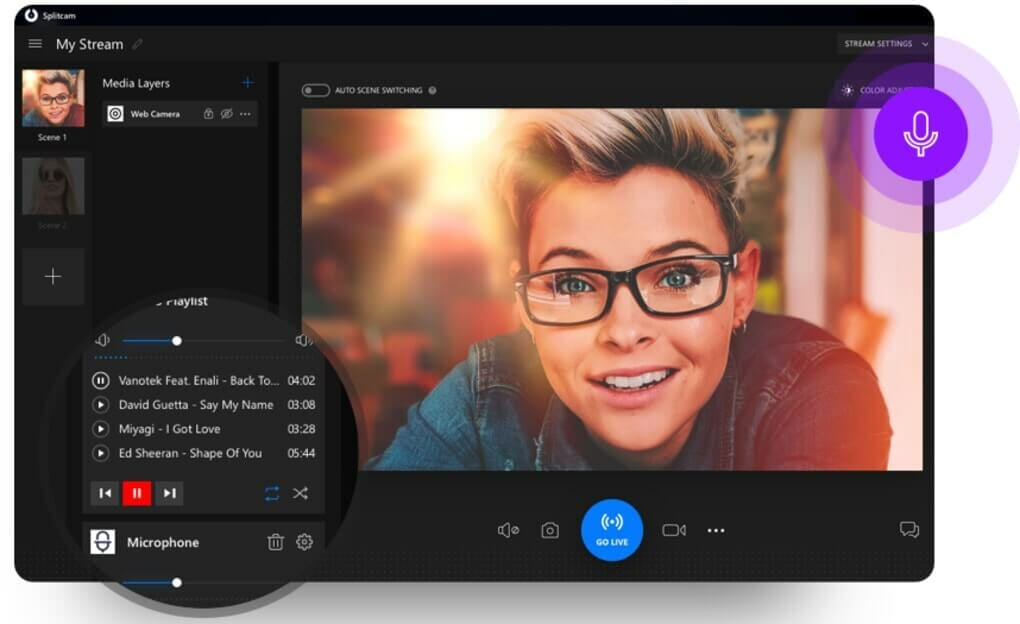
Restream Business is designed for companies that need to stream both internal and public events securely, making it one of the top private video platforms with DRM and token protection.
This private broadcasting platform allows you to stream a secure internal meeting while simultaneously broadcasting a public version to social platforms. It’s perfect for corporate communications, hybrid events, and secure live video streaming for teams.
Basic Functionality
Restream Business supports multi-destination streaming, private access links, and video access control tools for confidential live video solutions. It integrates easily with professional encoders and platforms like Dacast for enterprise video platform workflows.
Key Features
- Private and public streaming from the same event
- Password protected video streaming
- Enterprise SSO for secure employee access
- Detailed analytics and engagement tools
- Supports hybrid streaming for internal and external audiences
Pros
- Ideal for internal company meetings and virtual events
- Flexible integrations with secure OTT video hosting
- User-friendly interface
Cons
- Limited branding options compared to full OTT platforms
Pricing
Restream Business pricing starts at $249/month, with higher tiers for enterprise-level streaming and API access.
Best for: Companies running hybrid internal and public streams with centralized control over private broadcasting platforms.
Comparison Table of the Top 13 Private Streaming Platforms in 2025
| Platform | Headline Features | Monetization Options | Security Tools | China Delivery | Pricing (Starting) |
|---|---|---|---|---|---|
| Dacast | Enterprise-level streaming, mobile-compatible apps (OBS/Larix), white-label, live + VOD | Paywalls, subscriptions, ads | Tokenized access, AES encryption, DRM, 2FA, password gating | Limited, via China CDN partners | $39/month |
| Uscreen Go | OTT apps, mobile-first streaming, white-label apps | Subscriptions, pay-per-view, rentals | Password gating, token protection, DRM | Not optimized | $49/month |
| Vimeo | Cloud-based live streaming, embeddable, multi-camera support | Subscriptions, pay-per-view | Password protection, domain restrictions, private links | Limited | $75/month |
| Zype | OTT app creation, live + VOD, API integration | Subscriptions, ads, pay-per-view | DRM, token gating | Limited | $199/month |
| Restream Business | Multistreaming, analytics, scheduling | Donations, subscriptions | Private streaming via password, token, or restricted links | No | $79/month |
| IBM Video Streaming | Enterprise video platform, analytics, global reach | Ads, pay-per-view, subscriptions | Tokenized access, DRM, encrypted streaming | Yes | $99/month |
| Wowza Streaming Cloud | Cloud-based live & VOD, low latency, API integration | Subscriptions, pay-per-view | DRM, AES encryption, IP restrictions | Limited | $49/month |
| StreamYard | Browser-based live streaming, easy production | Donations, memberships | Private links, password protection | No | $25/month |
| Brightcove | Enterprise streaming, analytics, live & VOD | Subscriptions, ads | DRM, IP restrictions, encrypted delivery | Yes | $199/month |
| Kaltura | Enterprise video platform, API & LMS integration | Pay-per-view, subscriptions | DRM, token gating, encrypted streaming | Limited | $100/month |
Top Platforms at a Glance
| Platform | Security | Monetization | Mobile App | China Delivery | Best For |
|---|---|---|---|---|---|
| Dacast | ✅ AES, DRM | ✅ TVOD, SVOD | ✅ Via OBS/Larix | ✅ | Business, Enterprise |
| Vimeo | ✅ Basic | ✅ PPV, subs | ✅ | ❌ | Creators |
| Wowza | ✅ Advanced | ❌ (via integrations) | ❌ | ✅ | Technical users |
| Uscreen | ✅ DRM | ✅ SVOD | ✅ Uscreen Go | ❌ | Creators, Educators |
| Kaltura | ✅ API-level | ✅ | ❌ | ❌ | Universities |
| Brightcove | ✅ | ✅ | ❌ | ❌ | Enterprise |
Best Private Live Streaming Apps for Mobile and Desktop (2025)
For live-streaming events with an emphasis on privacy, selecting the right platform is crucial. Whether you’re hosting a corporate event, an educational seminar, or a private celebration, using a private livestream app ensures your content reaches only the intended audience.
Here are six private live streaming apps that offer robust security features and a seamless streaming experience:
1. Vimeo
Vimeo remains a top choice for private live streaming due to its comprehensive privacy controls. Users can password-protect streams, restrict access to specific domains, or even make streams available only to members of specific groups. With Vimeo’s mobile app and desktop options, you can livestream privately in high-definition quality. Additional features like video embedding with restricted domains and analytics tools make it a versatile solution for professional and personal events.
2. StreamYard
StreamYard is celebrated for its simplicity and ability to simultaneously stream to multiple platforms while maintaining privacy. The platform offers unlisted links and password protection, allowing you to manage access easily. It’s particularly well-suited for webinars, business meetings, or private events requiring a polished and professional presentation. The browser-based tool eliminates the need for complex installations, making it a great option for non-technical users.
3. Zoom
Zoom is a reliable app for hosting private live streams, especially for webinars and virtual events. It offers robust features such as waiting rooms, meeting IDs, and end-to-end encryption to ensure security. Additionally, you can use password protection to limit access to your streams. Zoom also supports live streaming directly to platforms like YouTube or Facebook with additional security controls, providing flexibility for different event types.
4. Microsoft Teams
Microsoft Teams is another excellent option for private live streaming, especially in professional environments. It integrates seamlessly with other Microsoft Office applications and allows for live event broadcasting to specific internal or external audiences. Features like participant authentication, meeting lobby controls, and detailed access management ensure that only authorized individuals can join. Teams also supports video-on-demand (VOD) options, allowing attendees to revisit the content after the event.
5. Dacast
Dacast is a professional private live streaming platform that combines enterprise-level security with mobile flexibility. In addition to advanced features like tokenized access, geographic/IP restrictions, and AES encryption, Dacast works seamlessly with mobile broadcasting tools such as OBS for mobile or the open-source Larix Broadcaster. This makes it easy to stream privately from anywhere while maintaining full control over your content. Users can embed private streams on their websites, enforce app-level password gating, and enable paywalls for monetization. Dacast is ideal for educational courses, corporate events, exclusive content, and any scenario where professional private video streaming and secure live video delivery are essential.
6. Uscreen Go
This white-label live streaming platform lets you build branded OTT apps for iOS and Android. It’s ideal for private course streaming, fitness sessions, or professional training programs where you want complete control over access. As part of its secure OTT video hosting features, Uscreen Go supports password protected video streaming, app-level content gating, and token-based access control.
Other top private live streaming apps in 2025 also offer essential mobile security features, including:
- Two-factor authentication (2FA) for broadcaster logins
- Token gating to restrict streams to approved viewers
- Password gating at the app level for extra access control
If you are comparing secure private streaming platforms for mobile and desktop, consider not just the video quality but also the encryption, DRM, and video access control tools available. The top private video platforms with DRM and token protection give you peace of mind while delivering professional private video streaming for both live and on-demand events.
Whether you’re planning a private virtual event, streaming an internal company meeting, or launching a subscription-based OTT service, the best private streaming platforms for 2025 are those that combine flexibility, mobile readiness, and enterprise-grade security.
But Dacast is the only professional-grade mobile-compatible option with monetization + DRM.
7. YouTube (Private/Unlisted Streams)
While YouTube is often associated with public streaming, it also supports private and unlisted live streams. Private streams are viewable only by invited users with a Google account, while unlisted streams can be accessed via a specific link. This dual functionality makes YouTube a flexible and accessible option for smaller-scale private events or informal gatherings.
Each of these private streaming platforms provides the tools and security necessary to ensure your live events remain private and accessible only to your intended audience. By leveraging features like password protection, encryption, and restricted access, these apps help you maintain control over your content while delivering a seamless streaming experience.
Security Features to Look for in a Private Streaming Platform
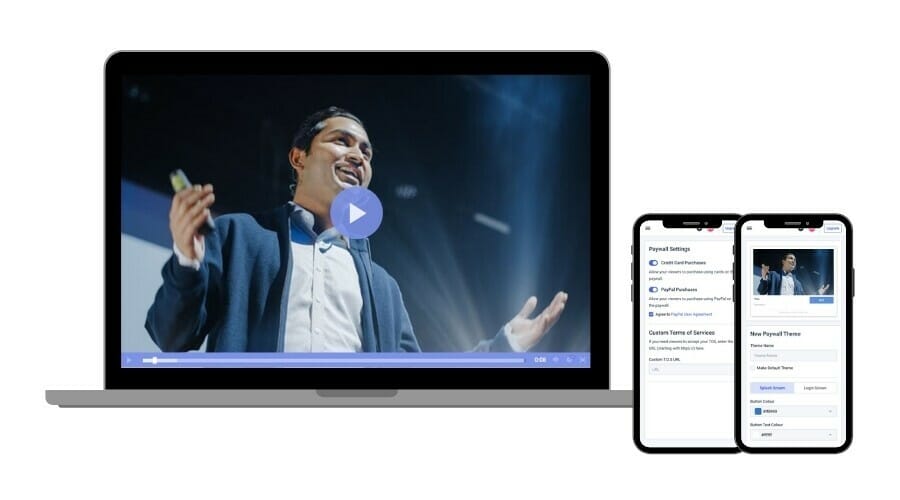
As we mentioned, broadcasting webinars, conferences, corporate events, or other private streams at a professional level requires different features for different broadcasters. However, there are a few features for video privacy and security that are universal for private live streaming.
These key private live streaming events features include password protection, geographic and referrer restrictions, and payment security. Let’s take a closer look at each of these features.
1. Password Protection
Password protection is one of the most basic forms of security for private. It is often considered a “first line of defense” for private streaming.
This feature allows the broadcaster to set a password. Any viewers who attempt to access the stream will have to enter the password as prompted to have access. It’s an ideal setup for smaller events among trusted individuals or groups.
Many live streaming solutions come with password-protected video hosting features.
2. Geographic and Referrer Restrictions
As the name implies, restrictions allow broadcasters to restrict who can access your content. Also, you can set these restrictions based on a variety of factors.
There are two types of restrictions in common use. Geographic restrictions allow you to restrict who can access your online video via IP address. Unless someone is using a VPN, IP corresponds to geographic location.
This tool works by “whitelisting” countries where your audience can view your content. That way, you can bypass hackers or unauthorized people who reside in other countries.
The second type is referrer restrictions. A referrer describes the website a visitor visited before accessing your video content.
Thus, a referrer restriction allows you only to allow users who came from pages on your domain (for example, https://www.dacast.com/*). The asterisk (*) symbol indicates that any page on your site is acceptable to users.
This restriction effectively prevents users from illegally embedding your stream on another site. Even if the embed does work, the video won’t play. That helps to combat piracy.
3. Payment Security
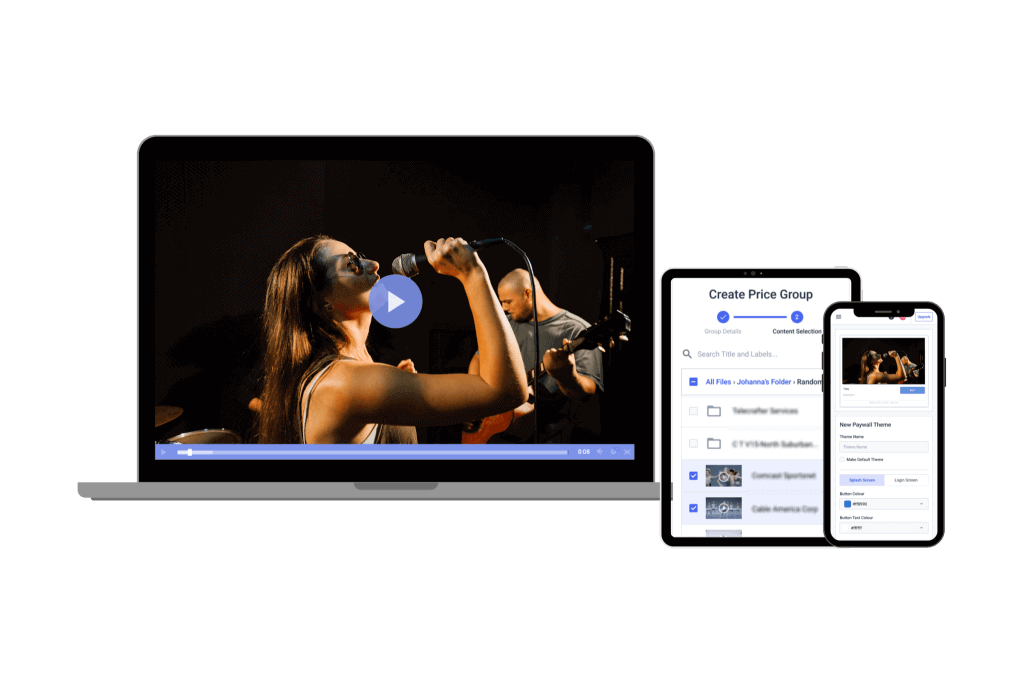
Another great way to keep content secure is to require viewers to pay for access. It also provides a revenue stream for your live broadcasts. However, when money is involved, payment security becomes exponentially more important.
Luckily, online payment systems are now stronger than ever. For example, a tokenized security system can support these authorization schemes. In short, a tokenized security system replaces the payment details with tokens instead of storing your audience’s sensitive payment details. Your audience’s sensitive information is protected if you’re hacked for whatever reason. That prevents anyone without prior authorization from accessing your secure stream.
Note: make sure the live-streaming platform you choose uses SSL encryption for payment information.
4. AES Encryption
AES, short for “Advanced Encryption Standard,” is an industry standard for encryption and is known for its speed and security. In other words, it’s one of the best encryption protocols to allow a live stream to be securely delivered without disruption.
There are three types of AES encryption to know about: 128-bit, 192-bit, and 256-bit. The numbers denote the key length. It may seem obvious that 256-bit would offer the most protection, which is true, but it comes at the cost of resources. For example, watching a video that uses 256-bit encryption rather than 128-bit encryption will drain your battery a little faster.
5. Digital Rights Management
DRM is a proven technology for addressing piracy. If you’ve ever tried to copy text from a website and then pasting didn’t work, or if you’ve ever tried to screenshot a page without success, you’ve likely come across DRM.
In short, DRM prevents the unauthorized use of videos and gives video content creators more control over how their videos are distributed. Keep in mind that although DRM is effective, unfortunately, there are tools out there to work around DRM that sometimes work.
That’s why when looking for ways to protect your videos. You need to take a more comprehensive approach. DRM is just one tool of many in your security-related toolbox.
6. Watermarking
On top of offering a way to personalize your videos, watermarking your videos is a good way to reduce the likelihood and negative effects of piracy.
Watermarking is a way of tattooing your video with your brand logo so no one can claim credit for your video. If it does get illegally distributed, at least the source is identified.
The private streaming platforms that offer this feature usually make it easy to add. For example, with Dacast, you can upload the image you want as your watermark once to add it to all live channel videos.
7. Video Analytics
Video analytics has come a long way since its conception, and its application in live streaming can give your efforts the boost your brand needs. By analyzing data collected from your previous video’s performance and audience’s response, you can make your upcoming live-stream content more relevant and dynamic.
While not directly related to security, think of video analytics as a safety pre-screening step before you start working on content ideas. Video analytics can provide valuable feedback that greatly reduces the guesswork associated with live streaming.
By identifying the categories in which your content tends to perform best, you can save yourself a lot of wasted time and resources by doubling down on what’s shown to bring in results.
8. Biometric Login for Admins
Many secure private streaming platforms now offer biometric login options for administrators, such as Face ID or fingerprint scanning. This adds an extra layer of privacy, making it harder for unauthorized users to access your account. Biometric authentication also streamlines login for busy teams, ensuring that managing professional private video streaming is both secure and convenient.
9. AI-Powered Moderation
Professional private video streaming platforms are increasingly incorporating AI-powered moderation tools. These features automatically manage private chat, enforce access rules, and flag or block inappropriate activity. AI moderation helps maintain a safe, controlled environment for viewers, making it easier to comply with corporate privacy requirements and run confidential live video solutions smoothly.
10. Real-Time Analytics for Monitoring
Platforms like Dacast provide real-time analytics to monitor viewer behavior and detect potential unauthorized sharing. These insights allow you to respond quickly if content is being accessed improperly, giving you greater control over secure live video streaming. Real-time monitoring ensures your private video hosting solution remains safe while helping you understand engagement during events.
Private Streaming Platforms vs. Free Streaming Sites
New broadcasters often start with free streaming platforms such as Facebook Live, Instagram, Twitch, TikTok, or YouTube Live. These options are appealing because they are free and familiar, but they come with serious limitations for anyone seeking secure private streaming.
Dacast vs. YouTube for Private Streaming
- DRM: Dacast supports advanced DRM for content protection; YouTube does not.
- Monetization: Dacast offers flexible pay-per-view and subscription tools; YouTube’s monetization is ad-based and less customizable.
- Ownership: Dacast ensures you retain full rights to your content; YouTube reserves significant usage rights.
- Privacy: Dacast provides password protection, domain restrictions, and geo-blocking; YouTube content is generally public by default.
Pros and Cons of Using a Free Private Stream Platform
You can do live streams for free on these social platforms at the cost of next to no privacy or security features. Also, your video streams aren’t yours when you use free live-stream platforms. YouTube and similar free live-streaming platforms have more control than you’d think.
Think about the popular personal video streaming platform Vine, which shut down and left influencers blindsided. A quick Google search will also show you countless stories of YouTube accounts being shut down or demonetized for no reason.
On top of this, video monetization options are minimal. Free live video streaming services like YouTube Live also control what music you can use in your video and give you time limitations on the type of content you can share.
Some benefits of these platforms are that they provide a way for live streaming events online for free, they are well-known, and because you likely use them already, they tend to be super easy to use.
Pros and Cons of Professional Private Streaming Platforms
With so many free options, you might be tempted to skip out on creating a budget and go with one of the free options. However, having a well-thought-out budget can help you save money in the long run.
So while streaming life for free might be super appealing, you should try a more professional solution for your private stream hosting needs. Let’s look at some benefits of using a professional stream hosting service.
Pros of Professional Private Streaming Solutions
- More reliability: Professional streams are more reliable and perform better than free streaming. That’s because they have dedicated servers and better bandwidth, which helps reduce buffering issues.
- More features: Professional stream hosting offers more features and customization options than free streaming services. For example, you can create custom playlists, add captions and overlays, and use multiple cameras with professional streaming solutions.
- More security: Professional stream hosting platforms offer more security features to protect your content from being stolen or pirated. Some also offer IP filters to block viewers from specific regions and analytics tools to track viewer information.
- Ad-free streaming: With professional stream hosting, you don’t have to worry about annoying ads popping up in the middle of your content. There’s no ad-free streaming with a free option.
- Better support: Professional stream hosting services typically offer better customer support than free streaming services. They often have a team of tech-savvy staff who can help you with any issues you have.
Cons of Professional Private Streaming Solutions
- Cost: The cost is the biggest downside of professional stream hosting. It can be expensive, especially if you use a streaming service with many features.
- Learning curve: Professional stream hosting can have a steep learning curve, especially for first-time users. You need to learn the platform, get familiar with the features, and understand how to use them properly.
To sum up, many private streaming platforms offer free or affordable plans, knowledge-based articles, and 24/7 support to overcome these downsides of private streaming platforms.
Benefits of Hosting a Private Live Stream
Why Choose Private Streaming in 2025:
- Restrict access to invited viewers for greater content control
- Engage specific audiences on a more personal level
- Reduce promotion and marketing workload
- Offer exclusivity to strengthen customer relationships
- Ensure GDPR and CCPA compliance for data privacy
- Maintain control over licensing and syndication rights
- Avoid algorithm interference that affects reach and visibility
FAQs
1. What is a private live stream, and how does it differ from public streaming?
A private live stream is a broadcast that is restricted to a specific audience, ensuring that only authorized viewers can access the content. This contrasts with public streaming, where the content is available to anyone. Private streaming is ideal for events like corporate meetings, internal trainings, or exclusive webinars, where confidentiality and controlled access are paramount.
2. What security features should I look for in a private streaming platform?
When selecting a private streaming platform, prioritize features such as password protection, encryption, viewer authentication, and domain or IP restrictions. These measures ensure that only authorized individuals can access your content, safeguarding sensitive information and maintaining the integrity of your broadcast.
3. Can I monetize my private live streams?
Yes, many private streaming platforms offer monetization options. Features like integrated paywalls, subscription models, and pay-per-view capabilities allow you to generate revenue from your content. This is particularly beneficial for exclusive events, online courses, or premium content offerings.
4. How do I ensure high-quality streaming for my private event?
To maintain high-quality streaming, choose a platform that offers adaptive bitrate streaming, which adjusts the video quality in real-time based on the viewer’s internet connection. Additionally, utilizing a reliable content delivery network (CDN) ensures efficient content distribution, reducing buffering and latency issues.
5. Are there platforms that support both live streaming and video-on-demand (VOD) for private events?
Yes, several platforms support both live streaming and VOD for private events. This dual functionality allows you to broadcast events in real-time and make the recordings available for later viewing. Platforms like Dacast, Vimeo, and IBM Cloud Video offer such capabilities, providing flexibility for your audience to access content at their convenience.
Incorporating these FAQs can enhance the value of your article by addressing common concerns and providing readers with practical information on private streaming platforms.
6. What is a private live stream, and how does it differ from public streaming?
A private live stream is accessible only to selected viewers through tools like password protection, tokenized access, or domain restrictions. Public streaming is open to anyone, making it harder to control who watches or shares your content. Private streaming is ideal for secure corporate events, paid content, or exclusive communities.
7. What security features should I look for in a private streaming platform?
Look for encrypted video delivery, DRM, password protection, and domain or IP restrictions. Advanced options in 2025 include biometric login for admins and AI-powered moderation for chat and access control. Real-time analytics, like those offered by Dacast, also help detect unauthorized sharing.
8. Can I monetize my private live streams?
Yes, many secure private streaming platforms offer monetization options such as pay-per-view, subscriptions, or one-time access passes. A professional private video streaming solution like Dacast allows you to combine monetization with strong privacy controls. This lets you earn revenue while protecting your content.
9. How do I ensure high-quality private streaming?
Choose a platform with adaptive bitrate streaming, global CDN delivery, and robust encoding support. Test your internet upload speed before going live, and consider a wired connection for reliability. Using professional-grade private video streaming software ensures smooth playback for all viewers.
10. Which platforms support both live streaming and VOD for private events?
Several secure live video streaming platforms, including Dacast, offer both live and video-on-demand hosting for private events. This lets you record your live stream and make it available for on-demand viewing through a secure private video hosting solution. It’s ideal for hybrid events or post-event access.
11. Can I create a branded portal for on-demand private access?
Yes, white-label live streaming platforms allow you to create fully branded portals without third-party logos or ads. Dacast, for example, enables you to offer password protected video streaming in a custom environment that matches your brand identity. This is perfect for businesses wanting a professional, cohesive viewer experience.
12. How do I know my stream is truly private and secure in 2025?
Use a platform that offers encrypted streaming, DRM, tokenized access, and advanced access control tools. Verify that it complies with privacy laws such as GDPR and CCPA. With Dacast, you can combine these protections with real-time analytics to ensure only authorized viewers access your content.
Conclusion
Choosing the right private streaming platform is crucial to live streaming events successfully. Privacy and security are vital features if you want to control who has access to your meetings and video content.
Using this article, you’re now armed with the fundamental knowledge of how to choose the right private streaming platform for your live private stream. We’ve laid out the features, prices and security capabilities of the leading live-streaming platforms available.
As we’ve mentioned, Dacast is a professional-grade, flexible and ultra-secure streaming platform. With Dacast, you’ll have access to all the features you need to host high-quality and secure private live-streaming events. What’s more, with a wide range of pricing options you’ll find the perfect plan for your budget.
You can try Dacast and all its features right now, free for 14 days.
For exclusive offers and regular live broadcasting tips, you’re also welcome to join our LinkedIn group. We’d love to connect with you!
 Stream
Stream Connect
Connect Manage
Manage Measure
Measure Events
Events Business
Business Organizations
Organizations Entertainment and Media
Entertainment and Media API
API Tools
Tools Learning Center
Learning Center Support
Support Support Articles
Support Articles